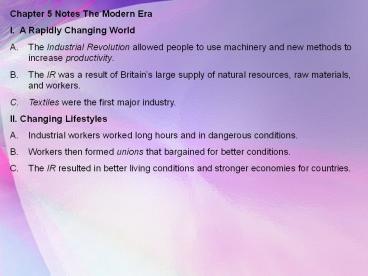Chapter 5 Notes The Modern Era - PowerPoint PPT Presentation
1 / 8
Title:
Chapter 5 Notes The Modern Era
Description:
Chapter 5 Notes The Modern Era I. A Rapidly Changing World The Industrial Revolution allowed people to use machinery and new methods to increase productivity. – PowerPoint PPT presentation
Number of Views:185
Avg rating:3.0/5.0
Title: Chapter 5 Notes The Modern Era
1
- Chapter 5 Notes The Modern Era
- I. A Rapidly Changing World
- The Industrial Revolution allowed people to use
machinery and new methods to increase
productivity. - The IR was a result of Britains large supply of
natural resources, raw materials, and workers. - Textiles were the first major industry.
- II. Changing Lifestyles
- Industrial workers worked long hours and in
dangerous conditions. - Workers then formed unions that bargained for
better conditions. - The IR resulted in better living conditions and
stronger economies for countries.
2
- III. Rivalry Between Nations
- Under imperialism, European countries claimed
colonies in Asia and Africa in the late 1800s - In 1914, WWI broke out in Europe and many
once-strong countries became weak and Germany
would be blamed. - In 1917, the Russian Revolution led to the system
of communism. - In the 1930s, worldwide depression and problems
that were not solved led to WWII. - After WWII, the Soviet Union and U.S. emerged as
world powers.
3
- Chapter 5 Notes (A Continent Divided)
- I. The Cold War
- Global competition between democratic U.S. and
Communist Soviet Union to spread its ideas. - Both sides had a large amount of nuclear weapons.
- The U.S. lent money to help rebuild Europe, and
to stop the spread of communism (Marshall Plan). - II. Cold War Alliances
- In 1948, the Truman Doctrine offered military aid
to those who were fighting communism inside their
borders. - In 1949, NATO was formed to respond to possible
attacks by the Soviet Union. - In E. Europe, the Soviet Union made satellite
nations of these countries which formed the
Warsaw Pact alliance.
4
North Atlantic Treaty Organization (1949)
- United States
- Belgium
- Britain
- Canada
- Denmark
- France
- Iceland
- Italy
- Luxemburg
- Netherlands
- Norway
- Portugal
- 1952 Greece Turkey
- 1955 West Germany
- 1983 Spain
5
Warsaw Pact (1955)
- East Germany
- Hungary
- Poland
- Romania
- U. S. S. R.
- Albania
- Bulgaria
- Czechoslovakia
6
- III. A Clash Between the Superpowers
- In 1948, the Soviet Union blockaded, closed off
Berlin which created much tension. - Germany would become split into W. Germany
(Democratic) and E. Germany (Communist). - The Soviet Union created the Berlin Wall to
prevent people from leaving E. Berlin. - IV. The End of the Cold War
- In 1985, Mikhail Gorbachev, introduce reforms to
stimulate the economy. (glasnost/perestroika) - In the late 1980s the Soviet Union moved towards
capitalism and democracy and as a result their
satellites became independent.
7
Post-War Germany
8
- Chapter 5 Notes (Moving Toward Unity)
- I. The End of the Soviet Union
- Protests in E. Germany led to the Berlin Wall
coming down and the reunification of Germany in
1990. - In 1991, Soviet Union broke up which 15 new
countries formed. - II. The New Europe
- Today, Europe is becoming an economic power.
- Some Europeans would like to see the European
Union become the United States of Europe. - Most of the EUs members use the same currency,
the Euro. - Some of the problems that the EU is trying to
solve is the income gap, population growth, and
environmental issues.































